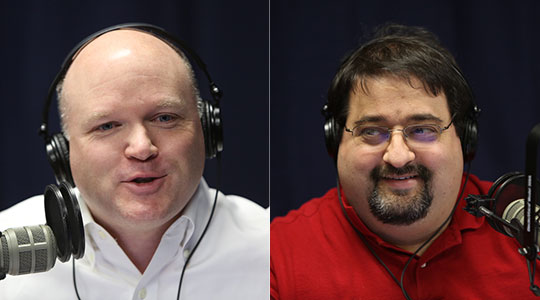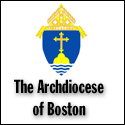Summary of today’s show: Easter is celebrated for a whole Octave (8 days) and we’re continuing to celebrate by looking at Cardinal Seán’s Easter Vigil homily in which he reminds us that the Resurrection is an event that should continue to change our lives. He notes that in the 40 days between Easter and the Ascension, Jesus readies the Apostles for the new reality they are experiencing, and so should we be readied because the tomb is empty, the tabernacle is full, and our hearts are full of laughter. Also, Domenico Bettinelli relates to Scot Landry the hilarious story of his near-disastrous experience of the Easter Vigil at his parish with his family of five children, six and under.
Listen to the show:
Podcast: Play in new window | Download
Watch the show via live video streaming or a recording later: BostonCatholicLive.com
Today’s host(s): Scot Landry
Today’s guest(s): Domenico Bettinelli
Links from today’s show:
Today’s topics: Cardinal Seán’s Easter Vigil homily
1st segment: Scot Landry welcomed Dom Bettinelli to the show. They started by recalling the Easter Vigil and Dom told the story of the near-disaster of attending Easter Vigil Mass at his home parish with his five kids. The complete story can be found at his blog:
2nd segment: This week’s benefactor card raffle winner is Joseph Marinna from Brighton
He wins the booklet Divine Mercy Explained by Fr. Michael Gaitley and an audio CD of the Divine Mercy Chaplet from the Congregation of the Marians of the Immaculate Conception in Stockbridge, MA.
If you would like to be eligible to win in an upcoming week, please visit WQOM.org. For a one-time $50 donation, you’ll receive the Station of the Cross benefactor card and key tag, making you eligible for WQOM’s weekly raffle of books, DVDs, CDs and religious items. We’ll be announcing the winner each Wednesday during “The Good Catholic Life†program.
3rd segment: Scot and Dom then offered commentary on Cardinal Seán’s Easter Vigil homily at the Cathedral of the Holy Cross in Boston as summarized below:
He started by talking about the medieval custom that a bishop’s homily on Easter should start with a witticism because on Easter we are supposed to laugh at death. Cardinal Seán then read some of his favorite witticisms found on tombstones.
Here lies the body
of Jonathan Blake
Stepped on the gas
Instead of the brake.Under the sod and under the trees
Lies the body of Jonathan Pease.
He is not here, there’s only the pod:
Pease shelled out and went to God.
But Jesus’ tomb has no epitaph because there is no body in the tomb. The borrowed tomb is empty. And the last thing Magdalene expected was to see the risen Lord.
The disciples were hard to convince that Jesus rose from the dead, far from foisting a story on others.
The question we need to answer: Why do you seek the living among the dead? So many still look for Jesus among the dead. Some regard him as one of the greatest people of history, but that is not enough. Jesus is not some distant historical figure, merely a hero of the past or a story to be studied. We study Easter to day and each sunday because Jesus is alive. Our redeemer lives, calling us to conversion, discipleship and mission. Like the disciples we too are on a quest to discover meaning in our lives and path that will lead us to God and salvation.
When they struck the shepherd the sheep were scattered on Good Friday. Jesus was crucified and the followers dispersed into hiding. On Easter, the Good Shepherd returns to gather the flock. The Gospel of the 40 Days: Jesus impresses on the disciples the new modality in which he will be present to them everywhere in the world and for all time. One of the ways is in the sacraments. On Easter, the Risen Lord breathes on the apostles and gives them the Holy Spirit for the sacrament of penance. He tells them to go make disciples of all nations, baptizing them in the name of the Father, Son and Holy Spirit. And they recognize Jesus in the Eucharistic gesture in the breaking of the bread at Emmaus. Jesus disappears but the Eucharist remains.
The empty tomb was but the first hint that the resurrection took place. Far more important were the apparitions that took place during the 40 days of easter in which they were able to eat with Jesus and hear his instructions. Only now do the disciples begin to understand their mission and vocation and it is Pentecost when the Church is born.
Faith in the resurrection was connected to the work of the Holy Spirit that inspired them to write down the Gospels and the New Testament.
150,000 adults throughout the US were baptized at the Easter vigil. The extended readings that recall the great events of salvation history, the blessing of fire and water, all focus us on the most important event in history, the Resurrection. Today the Church calls on all of us to renew our baptismal promises, recommitting ourselves to our membership in Christ’s family, the Church.
No other event in history has marked us a deeply or as permanently. It is because Jesus is risen that we are who we are. the commercialization of our culture has confused people to be confused about their identity and their worth. Eating disorders tell women they can never be thin enough. Millions of images challenge us that we aren’t good enough. Advertising tell us that we have an inadequate or poor image and we need to be made over for a price. Our mission is to be beautiful and feel good, not to be holy and remake the world.
The cartoonist Jules Feiffer made a cartoon featuring a boy named Danny who said he’d never wanted to be himself but like another boy named Billie, so he imitated him, but he was imitating someone else, and so on and so on. Archbishop Tutu once said he always preaches to his people that God loves them, because the entire culture tells them that they are unloveable.
Each one is a child of God. Baptism is a basic, irreversible identity that bestows on us the dignity of being God’s child. It resists redefining by culture. It is our truest and lasting identity as children of God and disciples of Jesus Christ.
At Jesus baptism in the Jordan, the voice of the Father was heard: “This is my beloved Son.” Our baptism was the same. We have been defined forever as God’s children. No one can take that from us. We have been given the mission of baptism, to do the works of Christ, to continue his mission to build a civilization of love, to manifest the merciful faith of the Father, to serve the poor and needy, to invite other to a life of community and discipleship.
We should be reminded of our responsibility to welcome and invite people into the Church. We stand before the empty tomb and rejoice that the Holy Sepulchre is empty, the tabernacle is full and we can still laugh at death.








Comments Closed